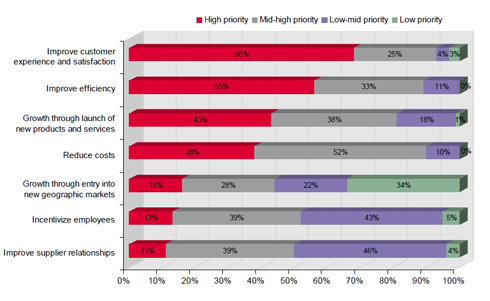By: Jesse Cryderman

There is a story floating around the interwebs that claims CEM was the most overused buzzword at this year's Mobile World Congress (MWC), and I'd have to agree. From service assurance products to policy controllers to re-branded analytics suites, most folks at the Fira in Barcelona were head over heels for CEM. The acronym was like the promise of 4G in the UK incarnate: Everything, Everywhere. (Oddly enough, robust WiFI, another trending topic this year, was nowhere to be found.)
Certainly some companies have done little more than slap a new name tag on an old solution. More than a me-too marketing tactic, however, there are very real reasons behind the trend: CSPs, particularly network operators, are at constant risk of becoming commodities, and they recognize a pressing need to differentiate in new ways, and they've targeted customer experience management (CEM) as a top priority (figure 1).

Telco Business Goals
Source: Ovum
Fact is the simple difference between being a commodity or not simply has to do with the level of differentiation or uniformity of a product or service has from the customer perspective. Coal is coal. Copper is copper. Connectivity is connectivity. But, CEM – among other things – can enable CSPs to truly distinguish their offerings and the customer experience by enabling them to differentiate their offerings from that of their competition.
The abundance of CEM solutions on the market and varying definitions of the phrase also created confusion; it seems the industry is still learning how to "do" CEM, and it's aware of its shortcomings. SAP recently reported that although 80% of the executives they surveyed named customer experience as a top priority, yet only 20% thought they were doing it right. Those numbers are quite accurate. In fact, in the US, among wireless service providers, the American Customer Satisfaction Index showed customer satisfaction fell 1.4% from 2010 to 2011.
There's certainly room for improvement; as a whole, the mobile industry is still wrestling to develop a business model that both produces profit and delivers a seriously improved customer experience.
As research group Ovum recently opined, "If telcos want their customers to become loyal and satisfied promoters of their services, they not only need to provide better customer service than their telco peers; they also need to match the level of customer service offered by companies in other service industries."
So what's the best way to tackle the ubiquitous acronym CEM? What are CSPs doing today, and what's working?
A New Hero
Over the past three years, top tier carriers began hiring customer experience leaders—multi-lateral champions of CEM that advocate a customer-centric policy across all functional groups in an organization. With titles like VP of Customer Experience and SVP of Customer First Culture, this new class of telecom exec is tasked with turning organizations that have been primarily network-focused to agile businesses that have deep insight into their customers' needs, usage, and overall experience. With the move to a customer-centric paradigm, new spending initiatives have followed.
BT, for example, is investing roughly $117M on providing a, "simple and complete global customer experience," by improving customer service, simplifying their CRM infrastructure, streamlining incident reporting, and enhancing network availability. Last year, the CSP tapped Alcatel-Lucent for its ServiceView Solution Suite to support its high-speed Internet, IPTV and VoIP services.









